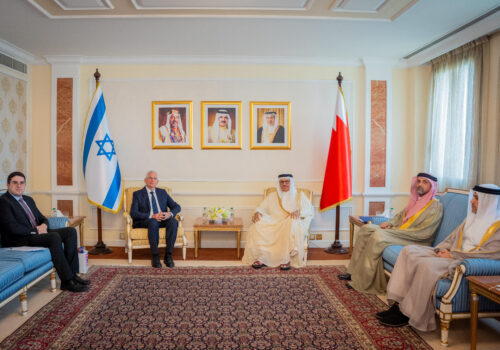Are the Abraham Accords heading towards their toughest test yet? Having so far survived the ongoing war in Gaza, the landmark normalization agreements between Israel and its Arab and Muslim neighbors will be facing a new challenge if Israel decides to go forward with the annexation of the West Bank.
The United Arab Emirates (UAE), which has already once managed to cancel Israeli annexation plans in 2020, came out with a strong statement last month saying that annexing the occupied West Bank would cross a “red line” and undermine the spirit of the Abraham Accords that established relations between the two countries.
But as the UAE raises the diplomatic stakes on such actions, domestic pressure on Prime Minister Benjamin Netanyahu to declare sovereignty and annex parts of the West Bank is growing. In the past, this was called for by the smaller right-wing parties and right-wing members of Netanyahu’s own Likud party. Today, many Likud members, including some of the most prominent party officials, are calling for the annexation of West Bank territory. There are several reasons why the demand is on the rise.
The main one is the feeling that US President Donald Trump’s administration will support such a move or at least won’t object to it. This creates a relatively narrow window of opportunity between now and a possible fall of the Netanyahu government. Even though elections are set for October 2026, there is a growing belief that the current Netanyahu government will not make it there, and early elections may take place already in June. But, once elections are set, possibly by the end of March, the government becomes an interim caretaker government, which does not have the power to take such action. There is also a growing public sentiment for this in the wake of the October 7, 2023, Hamas massacre inside Israel. Having witnessed the result of an independently ruled Palestinian Territory, more and more Israelis, even those who have previously supported the two-state solution, do not want to have such an entity within mortar range of Israel’s heartland. Therefore, on July 23, the Knesset (Israeli Parliament) held a non-binding vote on annexation, which had seventy-one members in favor and only thirteen against.
The second reason calls for annexation are on the rise are statements by several countries, led by France, to recognize a Palestinian state. These calls have increased support within the Israeli government for annexation for two reasons. The first being that an un-negotiated change to the Oslo Accords status quo is seen by some Israeli leaders as nullifying the Oslo Accords. Second, some Israeli leaders see annexation as a punitive measure and a warning for those countries that such an act will force Israel into unilateral action.
Possible annexation steps
Today, the West Bank is divided into three zones, based on the Oslo Accords, which envisioned these divisions to be temporary, with the final division of the land to be negotiated.
Area A is fully controlled by the Palestinian Authority (PA) and makes up 18 percent of the territory. It is mainly comprised of the major Palestinian cities and the surrounding area. Area B is administered by the PA, but Israel is in charge of security. It makes up 22 percent of the territory and is comprised mainly of Palestinian villages. Area C makes up 60 percent of the territory, and Israel is fully in charge of it. The number of Palestinians living in Area C is estimated at 200,000-300,000, and the number of Israelis is around 400,000.
SIGN UP FOR THIS WEEK IN THE MIDEAST NEWSLETTER
There are three possible annexation scenarios. The first is the annexation of the Jordan Valley. This was proposed already in 1967 as part of the Alon plan during the Labor Party’s rule. The Knesset has tabled legislation suggesting this several times since 1992. In 2019, Netanyahu, as part of his election campaign, proposed annexing the Jordan Valley, from the river to the Alon Road. The area in question amounts to between 17 and 22 percent of the West Bank, depending on the plan. For Israelis, the main advantage of this scenario is creating a barrier between the West Bank and Jordan, to hinder a future connection of the two. The border between Gaza and Egypt, also called the Philadelphia route, was a highway of arms smuggling. Therefore, Israel would like to separate Jordan and the West Bank and maintain a wide barrier between the two. A second concern is a future Jordan, which is overtaken by its Palestinian majority or worse by a Jihadist regime and connected to the West Bank. In 2020, the Netanyahu-Ganz Government set a date for the annexation of the Jordan Valley in its coalition agreement. While the right-wing factions were looking for something bigger, relying on the first Trump administration to support this, Netanyahu, as part of the Abraham Accords and as demanded by the UAE, officially took this idea off the table. As most of this area is considered C under the Oslo Accords and has a relatively small Palestinian population, annexing the Jordan Valley might not provoke the same level of pushback as other scenarios, Therefore, senior Israeli officials believe that this will most likely pass with a lot of condemnation and maybe even a “cooling off” period in the Abraham Accords—but it won’t terminate the agreements.

The two other options are much more far-reaching. The second option suggests annexing “settlement blocks”. This area amounts to 7-23 percent of the territory but creates a very problematic map with isolated settlements and very long and impossible to defend borders, meaning the Israeli army will still want to be on both sides of it. The rationale of this plan is that almost all Israelis will find themselves in Israeli territory. At the same time, the number of Palestinians, who most likely will be offered residency in a similar way to the Palestinians in East Jerusalem, is relatively small. Those on the Israeli right object to this plan, claiming that any area not annexed will de facto become the foundation of a Palestinian state. Therefore, the annexation should be done in one step to determine the borders.
The third option that is being pushed forward by the right-wing factions calls for the annexation of 82 percent of the area, leaving out only the cities and Palestinian “village blocks” which will be left in the hands of the PA (most of area A and parts of area B). Under this plan, some eighty thousand Palestinians will find themselves under Israeli rule. Such a plan was recently tabled by Minister of Finance Bezalel Smotrich.
Netanyahu’s political dilemma
The government is facing challenges around several issues. The main one is the “equality in carrying the burden,” legislation required by the Supreme Court to include the extreme orthodox in the conscription from which they are mostly exempt today. The extreme orthodox parties do not agree to a law that will mandate them to enlist in large numbers, and have left the governing coalition, leaving it hanging on a thin thread with exactly 50 percent of the seats. This gives the right-wing parties more leverage regarding annexation or any other issue. By December 31 of this year, the government has to pass the budget bill. Failing to do so by March 31 mandates speed elections within ninety days. Without the extreme orthodox parties at least abstaining, the budget is unlikely to pass. Netanyahu likely assesses that one way to keep the remainder of the coalition tight could be around annexation. On another front, the two right-wing parties threaten to leave the coalition and government should a deal be struck with Hamas, which does not satisfy their demands for the dismantlement of Hamas and maintaining security control over Gaza. Here, too, Netanyahu may be able to pacify them with the prospect of annexation. Most polls show that early elections may lead to a new centrist-left government, which may help Netanyahu keep his coalition in order, but may cost him annexation.
The consequences of annexation on regional integration
The growing debate in Israel around the issue has sparked a lot of international pushback. Netanyahu, with elections looming, wants to create a series of successes which may win him another term in office. One of his goals, after ending the war in Gaza, hopefully with all remaining or most hostages back, is to normalize relations with Saudi Arabia. This will most likely not be possible if annexation goes through. Saudi Arabia strongly condemned Israeli officials’ statement on the matter. Sources present in a recent meeting between Crown Prince Mohammed Bin Salman and UAE President Mohamed bin Zayed said the two agreed that a pullback from the Abraham Accords would be a “realistic” option should moves toward annexation be made.
The US position on annexation is not completely clear. In 2020, it seemed there was a green light for partial annexation. When asked about annexation in July, a State Department spokesperson said that “we stand with Israel and its decisions and how it views its own internal security.” What is Trump’s feeling on this? Just last week, he declared that he would “not allow” Netanyahu to annex the West Bank.
Understanding the key is in Washington, the UAE has warned the White House that annexation could unravel the Abraham Accords. If such annexation becomes a problem in the relations between the United States and the Arab world, Trump may object to it, despite some in his inner circle supporting it, and he may have the final word on this. If Trump makes a strong statement against any annexation, it will be very difficult for Netanyahu to go through with any such plans. This is one of the issues discussed by Israel’s Minister of Strategic Affairs Ron Dermer with senior US officials. On the other hand, Trump’s relatively strong relationships with Gulf countries, in particular, may help him mediate a small-scale annexation to the Arab world through a regional deal.
Itai Melchior is a nonresident senior fellow with the N7 Initiative, a partnership between the Atlantic Council and Jeffrey M. Talpins Foundation. Melchior is a former diplomat, civil servant, and business leader.
Further reading
Fri, Sep 26, 2025
For an increasingly isolated Netanyahu, it’s money time with Trump
MENASource By Shalom Lipner
Amid growing international criticism, the Israeli Prime Minister is playing his ace—or rather, his Trump—card in Washington.
Fri, Sep 19, 2025
How Israel’s strike on Doha is forcing a Gulf security reckoning
MENASource By
The Gulf monarchies have displayed strong unity at a time when rethinking twenty-first-century Gulf security is no longer optional.
Thu, Sep 18, 2025
Insights from Israel and the Gulf: An evolving regional integration
MENASource By
At a moment when the Abraham Accords is in question, we witnessed how the region moves quietly, sometimes boldly, towards cooperation.
Image: An Israeli settler talks on mobile in a house in the old city of in Hebron in the Israeli-occupied West Bank September 3,2025. REUTERS/Mussa Qawasma TPX IMAGES OF THE DAY




